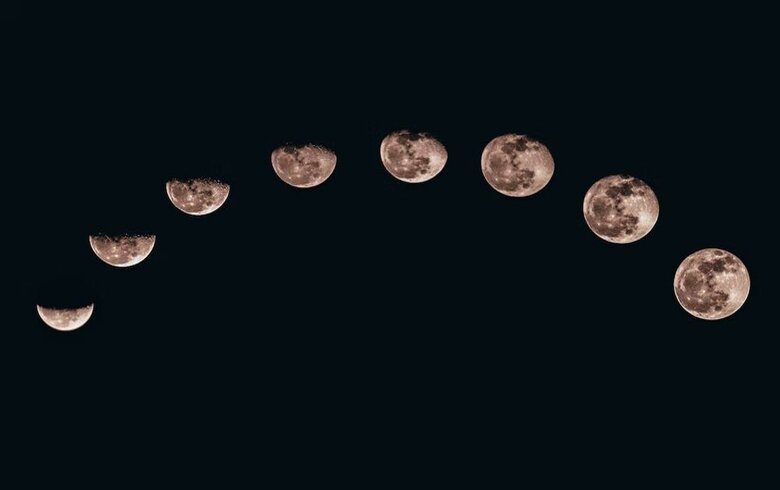The influence of the moon on tides is widely known, but the moon’s impact extends to various factors beyond the sea. It’s understood that the different phases of the lunar calendar can also affect humans, animals, and plants, including marijuana plants. Thus, this post aims to show how important a lunar calendar is to grow cannabis and how to use it.
How does a Lunar Calendar work?
The lunar calendar is based on lunar cycles and serves as a way to measure and calculate time according to the moon’s phases (lunations). These lunar phases result from the interactions between the movements of the sun, the moon, and the Earth.
The moon has a direct influence on plants and vegetation, emitting different types of rays depending on its phase. Despite being a celestial body that reflects light, it doesn’t have the strength to activate photosynthesis in plants like the sun does during the day. However, it regulates part of the photoperiod of any vegetation by stimulating the production of a plant-specific light receptor protein. Lunar rays affect the flow of sap within the plant and respond to gravitational forces.
We refer to a “lunation” as the interval between two identical phases of the moon, also known as the synodic period of the moon. This period has an average duration of 29 days, 12 hours, and 44 minutes.
Lunar calendar | Hemispheres
Before delving into the influence of the lunar calendar on cannabis plants, it’s important to understand the distinction between the two hemispheres and our location:
- Northern Hemisphere: Europe, most of Asia, North America, Central America, and most of the African continent are located in the Northern Hemisphere.
- Southern Hemisphere: The Southern Hemisphere encompasses the majority of South America, South Africa, Oceania, and Antarctica.
It’s important to note that when the moon is in the First Quarter phase in the Northern Hemisphere, it appears as a “C” shape, while in the Southern Hemisphere, it appears as a “D” shape.
Regarding the Last Quarter phase, in the Northern Hemisphere, it has a “D” shape, and in the Southern Hemisphere, it appears as a “C” shape.
Lunar calendar | Moon phases
We can define the phases of the moon based on the various shapes it takes as a result of its orbital motion around the Earth.
As a result, we identify four main phases of the moon:
New Moon
The moon hardly shines and your plants can’t detect light, so they’re growth will slow down. Sap descends the trunk completely, reaching the roots.This is a phase of adaptation and rest for your plants, in which they save up energy to spread the sap all over again.
This is the perfect time to prune or wire your plants, due to the fact that they’ll be resting and it won’t affect them as much. This way, the branches will sprout more quickly, and it’s also an optimal time for training and harvesting.
Despite being a celestial body that reflects light, the moon doesn’t have the strength to trigger photosynthesis in plants as the sun does during the day. However, it does regulate part of the photoperiod of any vegetation by stimulating the production of plant-specific light receptor proteins.
First Quarter
In this phase, the moon begins increasing the potency of the rays it emits, which causes plants to increase foliage and rooting. Sap begins ascending up through the roots, accumulating in the trunk and the branches. Towards the end of this phase is the best time to germinate your seeds, meaning that you’ll plant them on the first day of the full moon.
Full Moon
During this phase, the moon shines with more intensity, reaching its peak. This is reflected in increased sap circulation, moving upwards in the plant, reaching the upper parts such as the main shoot, branches, and leaves. It’s the ideal phase for transplanting, planting, and germination. Special care should be taken with insects since the higher sap content in the leaves can attract more pests. Experts recommend avoiding pruning plants during this phase.
Third Quarter
The intensity of moon light begins to descend, reducing leaf creation but inducing more root growth. Sap begins to descend again, accumulating in the bottom branches and lower trunk. The sap won’t reach the roots yet, so you can still transplant at this stage, although results won’t be as good as if you were to transplant during the full moon.
Moon calendar | Other uses
As we’ve already seen, the lunar calendar has various uses, not just in cannabis cultivation. This calendar can be considered in various tasks and activities, including:
- Agriculture
- Gardening
- Horticulture
- Forestry
- Beekeeping
In addition to the studied and confirmed influence of the moon on plants and vegetation, it’s believed that lunar phases also have an impact on humans, affecting their mood, behavior, sleep, menstruation, and to some extent, intellectual capacity.
These indications are not fully studied or proven, but it is believed that the type of energy produced by the moon is powerful enough to influence people in various ways.
[ppgbo products=”3388,444,523″ language=”en”]
Lunar Calendar | Cannabis and the Moon
Now, we can identify which hemisphere our country or region belongs to and, based on that, use the lunar calendar correctly.
We know that both the gravitational pull and the moon’s provided luminosity directly affect the production and development of marijuana plants. Therefore, it’s essential to always consider the moon’s phases, especially during critical stages like germination, pruning, and harvesting.
With an awareness of the lunar calendar, during the waxing phase of the moon when sap ascends towards the upper parts of the plant, it’s the ideal time for pruning or taking clones of our plants. On the other hand, during the waning phase of the moon when sap descends, it’s the ideal time for germination or planting.
Lunar Calendar for Marijuana 2024
Due to the importance of this calendar, it’s essential to know the best times of each month for germination, pruning, fertilizing, or harvesting. To understand the lunar calendar for marijuana in 2024, certain aspects need consideration.
Taking February as an example, the best days for each task are:
- For germinating seeds, it’s better from the 16th when the moon is in the waxing crescent.
- Conversely, for harvesting, the ideal day is from the 24th.
- Pruning should be done around the 9th, and for fertilizing, it would be interesting to do so from the 3rd.
Similar to February, you can decide the optimal time for each task by observing each month in the lunar calendar for marijuana in 2024.












